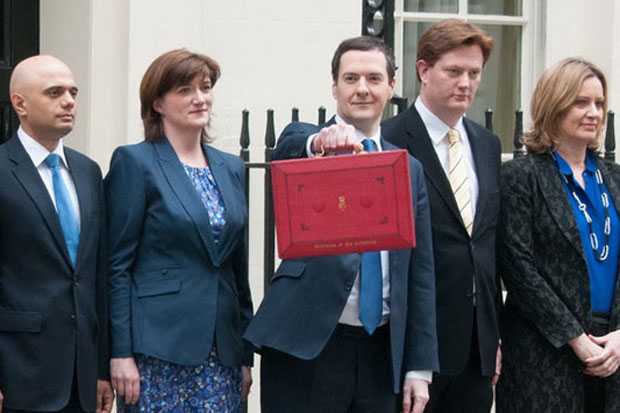18 March 2016
Budget 2016 – what it means to you
Chancellor of the Exchequer George Osborne delivered his eighth consecutive Budget speech this week (Wednesday, March 16, 2016).

It was the Chancellor’s second Budget Statement after last year’s Conservative Party win in the general election and followed a post-election Budget last summer.
Below we highlight the Chancellor’s key Budget measures that will impact on the company car and van sector and wider motor industry.
Company car tax
Company car benefit-in-kind tax rates up to the end of 2019/20 were already known (see table below), but the Chancellor did not announce rates for 2020/21 as had been expected.
That means that company car drivers will be selecting cars today which they could still be driving in 2020/21 without any knowledge as to what their benefit-in-kind tax bills will be.
At Budget 2013, the government committed to review the company car tax incentives for ultra-low emission vehicles in light of market developments at Budget 2016.
The Chancellor has now announced that the government has decided to continue to base company car tax on the carbon dioxide (CO2) emissions from 2020/21.
It will now consult on reform of the bands for ultra-low emission vehicles (below 75 g/km of CO2) to refocus incentives on the cleanest cars. That suggests that rather than a single rate of tax for cars with emissions of 0–50 g/km and for those with emissions of 51–75 g/km as currently there could be a series of graduated tax thresholds.
Vehicle Excise Duty
Vehicle Excise Duty from April 1, 2016 for cars registered on or after March 1, 2001
The Chancellor announced a rate of inflation increase for Vehicle Excise Duty rates, but the majority of charges have been held at their 2015/16 levels, notably for lower emission vehicles.
| VED | CO² emissions | 2016/17 | |
|---|---|---|---|
| Band | g/km | First year rate | Standard rate |
| A | Up to 100 | 0 | 0 |
| B | 101-110 | 0 | 20 |
| C | 111-120 | 0 | 30 |
| D | 121-130 | 0 | 110 |
| E | 131-140 | 130 | 130 |
| F | 141-150 | 145 | 145 |
| G | 151-165 | 185 | 185 |
| H | 166-175 | 300 | 210 |
| I | 176-185 | 355 | 230 |
| J | 186-200 | 500 | 270 |
| K* | 201-225 | 650 | 295 |
| L | 226-255 | 885 | 500 |
| M | Over 255 | 1,120 | 515 |
VED bands and 2016/17 rates for vans registered on or after March 1, 2001
Early Euro 4 and Euro 5 compliant vans – £140
All other vans – £230
Vehicle Excise Duty from April 1, 2017
As announced in last year’s post-general election summer Budget, Vehicle Excise Duty (VED) for cars first registered from April 1, 2017 is to change (see chart below).
First year rates of VED will vary according to the carbon dioxide (CO2) emissions of the vehicle. A flat standard rate of £140 will apply in all subsequent years, except for zero-emission cars for which the standard rate will be £0. Cars with a list price above £40,000 will attract a supplement of £310 on the standard rate for the first five years in which the standard rate is paid.
All cars first registered before April 1, 2017 will remain in the current VED system, which will not change.
New VED system for cars registered from 2017
| Emissions (g/km) of CO² | First year rate | Standard rate* |
|---|---|---|
| 0 | £0 | £0 |
| 1-50 | £10 | £140 |
| 51-75 | £25 | £140 |
| 76-90 | £100 | £140 |
| 91-100 | £120 | £140 |
| 101-110 | £140 | £140 |
| 111–130 | £160 | £140 |
| 131–150 | £200 | £140 |
| 151–170 | £500 | £140 |
| 171–190 | £800 | £140 |
| 191–225 | £1,200 | £140 |
| 226–255 | £1,700 | £140 |
| Over 255 | £2,000 | £140 |
Fuel Duty
Fuel duty will be frozen again in 2016/17, saving the typical motorist £75 a year and £270 a year for a small business with a van. By the end of 2016/17 fuel duty will have been frozen for six years.
Capital allowances
The 100% First Year Allowance (FYA) for businesses purchasing low emission cars will be extended for a further three years to April 2021. The 100% FYA had been due to end on March 31, 2018.
The main rate threshold for capital allowances for business cars, currently set at 130 g/km, will be reduced to 110 g/km of CO2 and the FYA threshold to 50 g/km from April 2018, to reflect falling vehicle emissions.
The Chancellor is giving companies a two-year window to react to the changes, which means that, thresholds for capital allowances on cars bought outright will be:
- Vehicles up to 50g/km (reduced from 75g/km): Companies can write down the full cost against their taxable profits.
- Vehicles emitting 51–110g/km: Companies can write down 18% of the cost of the car against their taxable profits each year, on a reducing balance basis.
- Vehicle above 110g/km: Companies can write down 8% of the cost of the car against their taxable profits each year, on a reducing balance basis.
It will also follow that leasing companies, which are ineligible to claim 100% first-year writing down allowances on cars, will be restricted to 18% (0–110 g/km) and 8% (from 111 g/km) on a reducing balance basis.
Car fuel benefit charge 2016/17
Employees who are in receipt of company-funded fuel used privately will see their benefit-in-kind tax bills rise from April 6, 2016.
The Chancellor confirmed in the Budget his Autumn Statement announcement that the fuel benefit charge multiplier for company cars would increase from £22,100 in 2015/16 to 22,200 in 2016/17. It will rise further by the rate of inflation from April 6, 2017.
Van benefit charge 2016/17
The van benefit-in-kind tax charge will increase from April 6, 2016 from £3,150 in 2015/16 to £3,170 in 2016/17, the Budget confirmed. It will rise further by the rate of inflation from April 6, 2017.
The government is to extend Van Benefit Charge support for zero-emission vans as follows:
- 2016/17 and 2017/18 20% of the main rate,
- 40% in 2018/19,
- 60% in 2019/20,
- 80% in 2020/21,
- 90% in 2021/22
- 2022/23 equalising with the standard charge
The government says it will review the impact of the incentive at Budget 2018 together with enhanced capital allowances for zero-emission vans.
In 2015/16 the rate for electric vans was 20% of that applied to conventionally fuelled vans and the rate had been expected to rise to 40% in 2016/17, 60% in 2017/18, 80% in 2018/19 and 90% in 2019/20 with the rates equalised in 2020/21.
Van fuel benefit charge 2016/17
From April 6, 2016 the van fuel benefit charge multiplier will increase from £594 in 2015/16 to £598 in 2016/17, the Budget confirmed. It will rise further by the rate of inflation from April 6, 2017.
Corporation tax
The Chancellor confirmed in his Summer Budget announcement that the main rate of corporation tax will be as follows:
- 20% in 2016/17
- 19% in 2017/18
- 19% in 2018/19 and 2019/20
- 17% in 2020/21.
Severn Bridge tolls
After the existing concession on the Severn River Crossings ends in 2018, the government will, subject to consultation, halve tolls, which are charged westwards only. Current toll charges are: Vehicle Category 1 (up to 9 seats) £6.60; Vehicle Category 2 (small bus up to 17 seats and goods vehicles up to 3.5 tonnes) £13.20; Vehicle Category 3 (18 seats and more and goods vehicles from 3.5 tonnes) £19.80. Motorcycles and UK disabled badge holders are exempt from toll charges.
Insurance premium tax
The tax was increased from 6% to 9.5% in November 2015 and it will rise from October 1, 2016 by a further 0.5% to 10% impacting on vehicle insurance and roadside assistance. The money raised is specifically earmarked to be spent on improving flood defences.
Salary sacrifice
The government is considering limiting the range of benefits that attract income tax and National Insurance Contribution (NIC) advantages when provided as part of salary sacrifice schemes.
However, the government says its intention is that pension saving, childcare and health-related benefits such as cycle to work should continue to benefit from income tax and NIC relief when provided through salary sacrifice arrangements.
Road infrastructure and maintenance
The government says it is making the biggest investment in transport infrastructure in generations and is increasing capital investment in the transport network by 50% over this Parliament compared to the last, investing £61 billion.
The government’s long-term approach to improving England’s motorways and major roads is marked in the Budget with the launch of its second Roads Investment Strategy, which will determine the investment plans for the period from 2020/21 to 2024/25.
A string of road improvement announcements across the country include:
- Accelerating the upgrade of the M62 to a four-lane smart motorway. The government will provide an extra £161 million on top of the existing road programme to bring forward by two years the upgrade between junction 10–12 Warrington to Eccles, and to accelerate work on junction 20–25 Rochdale to Brighouse.
- Developing the future transformation of east-west road connections, including a new Trans-Pennine tunnel under the Peak District between Sheffield and Manchester, as well as options to enhance the A66, A69 and the north-west quadrant of the M60. The government will allocate £75 million, including to develop a business case for these schemes by the end of the year.
In further transport infrastructure developments the government has:
- Given the green light to High Speed 3 between Leeds and Manchester, committing to reduce journey times to around 30 minutes.
- Allocated £80 million to continue planning for Crossrail 2 route which will connect South-West and North-East London, increase tube capacity and reduce the pressure on Victoria and Waterloo stations.
The Budget also saw the allocation of the £50 million Pothole Action Fund for England in 2016/17, enabling the repair of nearly a million potholes. The government will also provide a further £130 million to repair roads and bridges damaged by Storms Desmond and Eva.
Driverless cars
To establish the UK as a global centre for excellence Budget 2016 confirmed that the government will:
- Conduct trials of driverless cars on the strategic road network by 2017.
- Consult this summer on sweeping away regulatory barriers within this Parliament to enable autonomous vehicles on England’s major roads.
- Establish a £15 million ‘connected corridor’ from London to Dover to enable vehicles to communicate wirelessly with infrastructure and potentially other vehicles.
- Carry out trials of truck platooning on the strategic road network.
Motorway fuel price signs
The government has confirmed that the long-awaited trial of comparative fuel price signs on the M5 between Bristol and Exeter will start this spring to drive fuel price competition and help motorists save money.

